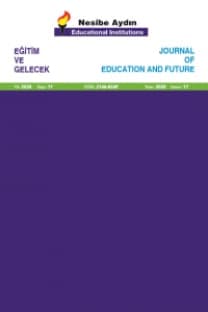Sibel Karaca* Özgür Yeşiloğlu ** Önder Şimşek
radyasyon, ortaokul öğrencileri, görüş
The Views of Primary School Students about Radiation
___
- Acar, S. B., & İnce, E. (2010). Internet as a source of misconception: Radiation and Radioactivity. Turkish Online Journal of Educational Technology, 9 (4), 94-100.
- Bickman, L. & Rog, D. (1998). Handbook of Applied Social Research Methods. Thousand Oaks, C.A: Safe.
- Boyers, E., & Stanisstreet, M. (1994). Children's Ideas about Radioactivity and Radiation: sources, mode of travel, uses and dangers. Research in Science & Technological Education, 12, 2.
- Colclough, N.D., Lock, R., & Soares, A. (2010). Pre-service teachers' subject knowledge of and attitudes about radioactivity and ionising radiation. International Journal of Science Education, 33, (3), 423-446.
- Glazar, S. A., Vrtacnik, M. (1992). Misconception of Chemical Concepts, Kemija v soli, Slovene. Journal of Chemical Education, (Special Issue) 5, 28-31.
- Hafele A. (2011). Exploring students thinking of atoms and radiation with the atom builder simülator. Paper present at the Proceedings the National Conference, Newyork, USA.
- Henriksen & Jorde. (2001). High school students’ understanding of Radiationand the environment: Can museums play a role? Science Education, 85 (2), 189-206.
- Itaki, C., Tomisawa, T., Ohgino, A., & Aizu, K. (2010). Study on risk communication in education of radiation protection: Risk perception in health sciences students.Paper present at, The 2nd International Symposium on Radiation Emergency Medicine at Hirosaki University, Japon.
- Kam, C. (2005). A survey on doctors' awareness and attitude of radiation dose of imaging examination in Hong Kong. Postgraduate Thesis. The University of Hong Kong, Medical Sciences, Hong
- Millar, R., Klaassen, K., & Eijkelhof, H. (1990). Teaching about radioactivity and ionising radiation: an alternative approach. Physics Education, 25.
- Millar, R., & Gill, J. S. (1996). School students’ understanding of processes Involving radioactive substances and ionizing radiation. Physics Education, 31.
- Morgul, I., Yılmaz, A., & Uludağ, N. (2004). Lise 2 kimya ders kitabında yer alan radyoaktivite konusunun incelenmesi, öğrencilerin bu konudaki bilgilerinin araştırılması ve öneriler. Hacettepe Üniversitesi Eğitim Fakültesi Dergisi, 27, 206-215.
- Mork, S. M. (2008). An interactive learning environment designed to increase the possibilities for learning and communicating about radioactivity. Interactive Learning Environments, 19, (2) 163-177.
- Neumann, S., & Hopf, M. (2012). Students' conceptions about `Radiation': Results from an explorative interview study of 9th grade students. Journal of Science Education and Technology, 21, 826-834.
- Nishina, K. (1999). The importance of early-school radioactivity education in cultivating proper reflexive judgement on radiation.Paper present at Nippon Genshiryoku Kenkyujo JAERI, Conf 361-365, Japon.
- Pilakouta, M. (2011). TEI Piraeus students' knowledge on the beneficial applications of nuclear physics. Paper present at International Scientific Conference, The Conference for the contribution of Information Technology to Science, Economy, Society and Education, Piraeus-, Greece.
- Prather, E. (2005).Students' beliefs about the role of atoms in radioactive decay and half-life. Journal of Geoscience Education, 53, 345-354.
- Rego & Peralta (2006). Portuguese students' knowledge of radiation physics Physics Education, 41, 259.
- Tada, J. (1999). Understanding radiation and risk: The importance of primary and secondary education. Japan Nippon Genshiryoku Kenkyujo JAERI, Conf 399-403.
- Yıldırım, A. ve Şimşek, H. (2008). Sosyal bilimlerde nitel araştırma yöntemleri (6. Baskı). Ankara: Seçkin Yayıncılık.
- Yin, R. K. (1984). Case StudyResearch: Desing and methods.Beverly Hills, CA: Sage.
- ISSN: 2146-8249
- Yayın Aralığı: 1
- Başlangıç: 2012
- Yayıncı: Nesibe Aydın Eğitim Kurumları
Ramazan Sak** Feyza Tantekin Erden*** İkbal Tuba Şahin Sak**** Hadi Esmeray
Ramazan SAK, Feyza TANTEKİN ERDEN, İkbal Tuba ŞAHİN SAK, Hadi ESMERAY
Guided Inquiry-Based Electricity Experiments: Pre-service Elementary Science Teachers’ Difficulties
Pattern Analysis of the First Part of Beethoven Waldstein Piano Sonata in Terms of Motives
Fatih Mehmet Ciğerci* Fisun Güngör
Fatih Mehmet CİĞERCİ, Fisun GÜNGÖR
Öğretmen Adaylarının Öğretmenlik Mesleğine Yönelik Tutumlarındaki Farklılıklar
Pre-Service Social Studies Teachers’ Perception of Global Citizenship
A. Selcen Arslangilay** M. Çağatay Özdemir
A. Selcen ARSLANGİLAY, M. Çağatay ÖZDEMİR
Sibel Karaca* Özgür Yeşiloğlu ** Önder Şimşek
Sibel KARACA, Özgür YEŞİLOĞLU, Önder ŞİMŞEK
Sınıf Öğretmenlerinin Okul Dışı Öğrenme Ortamlarından Yararlanmaya İlişkin Görüşleri
